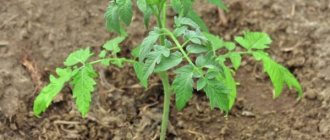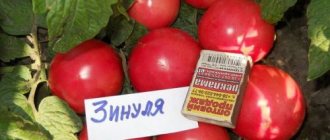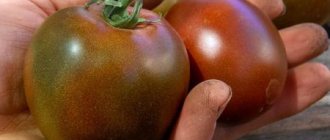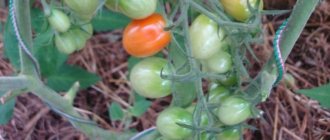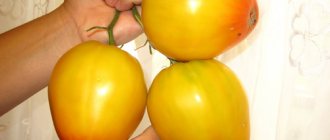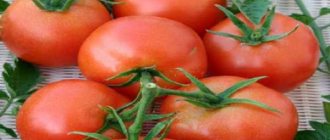Reading reviews about the Olesya tomato, you may decide that this is the ideal variety. People rave about its taste, hardiness, large fruit size and versatility. Thanks to its excellent taste, the tomato is gaining increasing popularity.
| Height | Landing location | Ripening time | Fruit color | Fruit size | Origin | Fruit shape |
| Tall | Greenhouse, Open ground | Mid-early | Orange | Large | Variety | Plum-shaped or oval |
Characteristics and description of the variety
Tomato Olesya can be grown indoors and outdoors. Experts recommend that vegetable growers from the middle zone and the Urals plant this variety in greenhouses and greenhouses. The variety is mid-season, ripening occurs 95–110 days after emergence. The variety is of indeterminate type, the height of the bush can be from 1.6-1.8 meters, so it is necessary to fix the plant to a support. The shoots are removed and the plants are formed into two stems.
The fruits of the Olesya variety are bright orange in color, elongated in shape, weighing 180–300 g. The taste is sweet, dessert with a characteristic tomato aroma. Tomatoes of this variety are good fresh; they are used to prepare juices, sauces, and ketchups; when whole-canned, the skin on the tomatoes bursts.
Verdict of summer residents
Gardeners share reviews about the Olesya tomato . The taste of the fruit received unanimous recognition. I'm pleased with the weight and shape.
Upsetting farmers:
- late ripening;
- thin brittle stems;
- the need for stepsoning and formation;
- cracking of fruits during heat treatment;
- keeping quality 1.5 weeks;
- slow ripening.
Summer residents note insufficient yield: those who planted received less fruit than the quantity indicated on the package. Tomatoes become smaller when plants are grown with 2 stems. It is difficult to grow Olesya in open ground in regions with short summers: late blight overtakes.
The advantages of the variety outweigh the disadvantages. Gardeners fell in love with tomatoes. The variety has taken a strong place in personal seed collections.
Pros and cons of the variety
- This variety has many advantages.
- Good taste.
- Increased immunity to late blight.
- The fruits tolerate long-distance transportation well.
- Increased productivity.
- Plants are unpretentious in care.
As negative aspects, gardeners mention the high growth of the plant, the need for garters and the removal of stepsons.
Main advantages and disadvantages
When considering the advantages and negative characteristics of a variety called Olesya, it is worth taking into account all the features of the culture.
First of all, the sweet, perfect taste of tomatoes and their pleasant aroma stand out from others.
The plant is able to grow and develop normally even when external factors are unfavorable. These include a number of diseases.
The application of high-quality fertilizer and timely staking guarantees the gardener a large harvest, each fruit of which will be neat and tasty.
Fact! The variety also has weaknesses. These include the negative “reaction” of the plant to high levels of soil moisture. This leads to cracks in the fruit. Many farmers also do not like to constantly trim the bushes if they are grown in a greenhouse, where there is not always enough space for a tall plant.
The delicious tomato variety Olesya, as in the photo, is recommended for growing in private farms due to its high taste and resistance to common diseases.
When the ovaries appear, remove the excess ones if you want to get large fruits, leaving up to 3 tomatoes on the flower cluster
pros
- average size of fruits and their attractive appearance;
- excellent taste properties;
- keeping quality and transportability;
- ease of care;
- low susceptibility to fungi.
READ MORE: Tomato is the pride of Siberia, characteristics and description of the variety, yield with photos
Cons
- mid-late ripening;
- thinness and fragility of stems and branches;
- average yield;
- in areas with short summers, the Olesya tomato may not ripen in open beds.
Growing technology
The variety is grown by seedlings. Sowing of seeds is carried out in the first half of March. Shoots appear at a temperature of +23–25 degrees. The sprouts sprout when two true leaves appear. When growing seedlings, it is important to maintain moderate watering. The water should be at room temperature, you can use clean melted snow. If the weather is cloudy outside, the plants are provided with additional light. For this, fluorescent or phytolamps are used. The first feeding of seedlings is carried out 10 days after germination. In this case, preference is given to nitrogen-containing fertilizers. The plant is planted in a greenhouse at the age of 60 days.
Important!
If the tomato seeds are not treated by the manufacturer against infections, you need to do this yourself. To do this, they are kept in a saturated solution of potassium permanganate.
Sunny areas with fertile soil are suitable for growing tomatoes. If the soil is poor, compost or manure is added in the fall. For 1 m², 1 large bucket of organic fertilizer is enough. After which the soil is dug up. You can also apply fertilizer in the spring. Before planting, add half a liter of humus or complex mineral fertilizer to each hole according to the dosage recommended by the manufacturer.
When planting, trellises are installed next to the plants so as not to injure the roots of the plants in the future. A distance of 50 cm is maintained between the holes, and 70 cm is left in the rows.
Planting and growing seedlings
The main distinguishing feature of Olesya tomatoes is their unpretentiousness. To obtain juicy pulp and a pleasant aftertaste, you must follow some recommendations during the growing process.
You can get good seedlings in the following case:
- The seeds are pre-soaked in an antiseptic solution. Such manipulation helps prevent the proliferation of pathogenic infections inside the soil;
- Planting of seed material is carried out in the second half of March. At this time, daylight hours increase on average by 3 hours;
- The earthen substrate is pre-calcined in the oven for 60 minutes. Failure to comply with this requirement increases the risk of infection of young shoots with a viral infection;
- When the first shoots appear, it is necessary to fertilize with mineral compounds. They will help increase immune protection for young plants and increase their growth rate;
- The indoor temperature should be 25 degrees;
- For growing indoors, special agricultural lamps are used. These devices will help increase daylight hours and speed up the process of photosynthesis;
- Regular ventilation and hardening of planting material will help quickly accustom young bushes to temperature changes;
- Before planting seedlings in open ground, it is necessary to provide mineral fertilizing. For this purpose, nitrogen and potassium compounds are used.
Care
This variety does not require special care; if necessary, it is important to water the plantings once a week, remove shoots and weeds, apply fertilizing and loosen the rows. Plants should not be overwatered, as excess moisture promotes the development of putrefactive diseases. As the bushes grow, staking and formation of the plant into two stems are necessary.
If additional roots are visible on the tomatoes, hilling is necessary. To prevent plants from being affected by various diseases, experts recommend observing crop rotation.
Feed the tomatoes 3-4 times per season. At the beginning of growth, nitrogen-containing fertilizers are used (ammonium sulfate, sodium nitrate, urea). Before flowering and during the formation of ovaries, phosphorus-potassium fertilizers are applied (“Nitroammofoska”, “Ammofoska”).
Advice!
For better pollination, plants planted in greenhouses must be shaken. They do this in the morning.
How to care
The variety does not require any special requirements in terms of care.
Watering is carried out only by drip method; it is enough to water the crop once every seven to ten days. When the air temperature gets warmer, the plants will need a little more water, but don't get carried away.
Growing the Olesya tomato variety, according to reviews, requires regular ventilation of the shelter.
Complex mineral materials for feeding at first are important for the crop. Then it is worth using organic material and feeding with calcium to avoid problems with the formation of ripe fruits.
After transplanting seedlings into the soil, you can more often use fertilizers that contain more nitrogen.
From the moment of flowering, you need to switch to using other fertilizers so that the plant puts its energy into creating the ovary, and not developing stems and leaves.
Diseases and pests
Bacterial cancer. This disease is easier to prevent than to cure. For preventive purposes, 10 days after planting in a greenhouse or open area, plants are treated with one of the following preparations: “HOM”, “Oxyx”, “Kurzat”, “Ordan”.
Mosaic. A mosaic pattern forms on the plants, after which the leaves curl and die. The infection spreads quickly and cannot be treated. For preventive purposes, use the following solution: milk (1 liter) + urea (1 tbsp) and water (10 liters). All components are mixed well and sprayed on tomato plantings.
Cladosporiosis. Fungal spores can be found in the soil, on tools, plant debris, greenhouse fittings, and even in the air. With high humidity, the fungus gets on the leaves of the plant, and irregularly shaped spots form. At first they become light yellow and then brown. Leaf tissue dies, productivity decreases, and in neglected forms the plants die. If the first signs of the disease are noticed on tomatoes, use drugs such as “Topaz”, “Quadris”, “Skor”.
Advice!
Next to the tomatoes you can plant marigolds, marigolds, and mustard. These plants secrete phytoncides that repel fungal infections.
The most common pests found on tomatoes are:
- Spider mite. To cope with the insect, the drugs “Karbofos”, “Aktellik”, “Vertimek”, “Fitoverm” will help. The mite is difficult to notice with the naked eye; most often, a thin web on tomatoes is visible. The insect feeds on the juices of the plant, after which it dies.
- Whitefly. The insect looks like small white flies. Moving through tomato bushes, the whitefly secretes a special substance on the surface of which a fungus develops. To get rid of this pest, tomatoes are sprayed with phytoverm or actellik.
- Slugs. Animals eat leaves and fruits. Ground shells are laid out around the plantings and tobacco is sprinkled around the bushes. It is easy to lure slugs to drink beer; to do this, place plates with the drink.
Reviews
Ekaterina, 35 years old:
“I liked the variety because of its large, sweet fruits; we eat them fresh and make juices from them. The Olesya variety is easy to grow; I regularly removed the shoots and fed them twice with complex fertilizers. We tried the first orange tomatoes in mid-July.”
Alexey, 42 years old:
“I’m growing the Olesya variety in the greenhouse for the second season. I noticed that the plants did not like extreme heat, so I often opened the greenhouse transoms and doors. The plants bore fruit almost until October; the unripe ones were collected and placed in a box. After a week at home, they also began to ripen. Fresh tomatoes kept well until the end of November.”
Svetlana, 48 years old:
“My grandchildren loved this variety for its sweet taste. These tomatoes make good juices, sauces, and fresh salads. We plant the plants in a greenhouse, immediately tie them up, and take care of them like other tomatoes. There were no pests on the bushes, so that late blight did not develop, the plantings were sprayed with phytosparin.”
Problems
By making mistakes in caring for a crop, a gardener risks paying for it with the harvest. It is important to be attentive to the crops you grow in order to be able to identify possible diseases or signs of insects in time.
Tomatoes of the Olesya variety, according to the description and reviews, often encounter black spotting, which is characteristic of surface rot. When a gardener waters a plant incorrectly, the disease becomes more serious. The first thing to do is to use mulch, adjust the watering schedule, and check the roots for signs of damage without disturbing their system.
